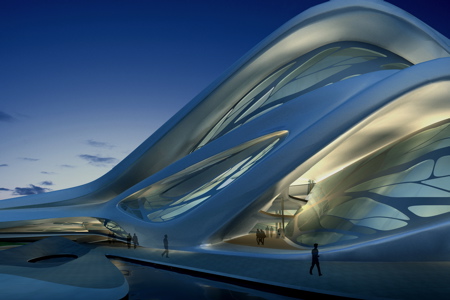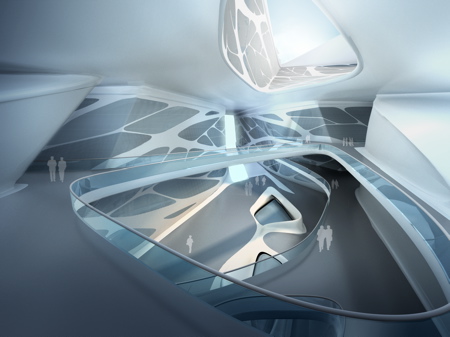

This complex is a new cultural institution for the Solomon R. Foundation Guggenheim on behalf of the Tourism Development and Investment Company of Abu Dhabi (TDIC).
The Abu Dhabi Performing Arts Centre will be one of the five major cultural institutions in the new cultural district of 270 hectares of Saadiyat Island in Abu Dhabi - developed by the Foundation Solomon R. Guggenheim on behalf of the Tourism Development and Investment Company of Abu Dhabi (TDIC).
The five institutions in Abu Dhabi, the Cultural District of Saadiyat Island:
1 of Abu Dhabi Performing Arts Centre by Zaha Hadid Architects
2 Museum of Contemporary Art (Guggenheim Abu Dhabi) by Frank Gehry Partners
3 Classical Art Museum by Jean Nouvel studies
4 Maritime Museum by Tadao Ando5 Sheikh Zayed National Museum: (Architect to be confirmed).
Zaha Hadid's building is a volume of 62 meters high with five theaters - a music hall, concert hall, opera, theater and a flexible theater with a combined capacity of 6,300 people. The Centre may also house an Academy of Performing Arts.
Performing Arts Center will be part of a multi-cultural district with other buildings of Frank Gehry, Jean Nouvel and Tadao Ando. In his own words, Ms. Hadid describes the structure as a "biological analogy" whose main components (branches, stems, fruits and leaves) is "transformed from these abstract diagrams in architectural design." We can only hope that such poetic biomimicry will lead Green functions, materials and technologies.

"As it winds through the site, increases in the complexity of the architecture, building height and depth and achieving multiple summits in the bodies housing the performance spaces, which spring from the structure like fruits on a vine and face westward, toward the water."The Abu Dhabi Performing Arts Centre is a continuation of the long relationship we have with the Guggenheim Foundation and the Emirate. We feel very honored to be part of the project," says Hadid.














 The building, with panoramic sea views and the city of Abu Dhabi, will be part of a set of institutions in the cultural district of Saadiyat Isalnd ranging from the Maritime Museum at its southern end to the Museum of Contemporary Art at the north end.
The building, with panoramic sea views and the city of Abu Dhabi, will be part of a set of institutions in the cultural district of Saadiyat Isalnd ranging from the Maritime Museum at its southern end to the Museum of Contemporary Art at the north end.Energy Performing Arts Center is symbolized by the dominant movements in the urban fabric along the central axis of the pedestrian walkway and promenade cultural center of the sea - the site of intersection of two elements."When this comprehensive and inclusive vision is realized, will set the standard for global culture that will be remembered for decades to come."Thomas Krens, Guggenheim Foundation Director said: "In Abu Dhabi, we have been lucky enough to find a partner who not only shares our point of view, but expands upon it. The plans for Saadiyat Island and the cultural district, conceived and developed by the Government of Abu Dhabi, are simply extraordinary.
On the north side of the building, the restaurant offers a large terrace, shaded roof, accessible via the adjacent conference center on the Lyric Theatre.The Abu Dhabi Cultural District on Saadiyat IslandSolomon R Guggenheim Foundation has been working with the Program of Tourism and Investment Company of Abu Dhabi (TDIC) to develop the five institutions of Saadiyat Island.
 The proposed Abu Dhabi Performing Arts Centre consists of five major theaters. The concert hall is above the lower four theaters, allowing daylight into its interior view of the skyline and dramatic sea and the city of the great window behind the stage. local pressure groups for each stage are oriented towards the sea to give the visitor a constant visual contact with their environment.
The proposed Abu Dhabi Performing Arts Centre consists of five major theaters. The concert hall is above the lower four theaters, allowing daylight into its interior view of the skyline and dramatic sea and the city of the great window behind the stage. local pressure groups for each stage are oriented towards the sea to give the visitor a constant visual contact with their environment.


